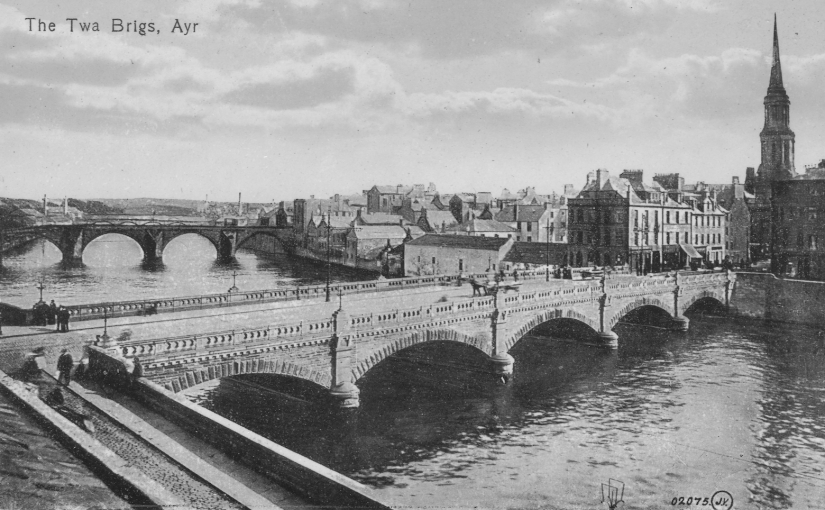Andy spent 1902 serving in the United Kingdom, where he was promoted to Lance Corporal and then Corporal. He achieved his 3rd class certificate of education (required for promotion to Corporal) in November 1902.
On 22 December 1902 Andy was part of a draft posted to India, where the 1st Battalion was on garrison duty.
Andy’s service record in The British National Archives (WO97 series) gives only the briefest outline of his time in India. Hart’s Annual Army List confirms the regiment’s movements, while details of soldiers’ daily routine in the heat and dust can be found in Richard Holmes’ book, Sahib: the British soldier in India 1750-1914.
The trip to India by steamer took about 6 weeks. Andy arrived in Calcutta [Kolkata] at the beginning of February 1902.
Andy joined the 1st Battalion at Jubbulpore [Jabalpur] in Bengal. He had arrived at the coolest time of the year and the weather into March would have been quite pleasant; cold, foggy mornings giving way to warm afternoons. Once summer arrived, however, temperatures shot north of 40 degrees, and work in the heat of the day became impossible. In Sahib one soldier describes the weather in May as “hot as human nature can well support”. The monsoon season brought some relief, but temperatures remained around 30 degrees until winter arrived in November.
As a new arrival, Andy was probably baited with tales of the poisonous snakes and man-eating tigers that lay in wait for the freshman soldier. There was some truth in these stories, as death by snake-bite was quite common in Jubbulpore. Tigers were less common, but did appear from time to time and caused great excitement. A tiger had been shot on the Jubbulpore golf links a few years earlier.

The nature of garrison duty in India meant that soldiers often had time on their hands. This gave Andy the opportunity to continue his education and work towards attaining his sergeant’s stripes. He studied writing and dictation, mathematics including proportions, interest, fractions and averages, and all forms of regimental accounting.
While only officers were required to study the Hindi language, Andy almost certainly learned enough colloquial language to speak pidgin Anglo-Indian with battalion servants and locals.
When not on duty men would occupy themselves by drinking, gambling at cards, playing backgammon or chess, and reading. Crafts were a popular activity. Perhaps it was in India that Andy learned or developed his woodworking skills to pass the time. A parquetry drinks tray and cribbage box crafted by Andy in later years have been handed down in the family.
Andy passed his class for rank of sergeant on 21 September 1903, and was awarded his second-class certificate of education on 23 March 1904.
In May 1906 Andy was stationed further east in Mhow, on transport duties. Then in 1907 the battalion was posted to Ranikhet Cantonment in northeast India. The move between garrisons probably consisted of a long, slow train journey of several days bookended by formal marches. The heat meant that the battalion would move at night and camp during the day. Sahib describes how the rest camps were alive with activity and noise:
The constant jabbering of the natives, and the roaring of the camels, together with elephants and buffaloes, reminds one of the striking contrast between India and peaceful England … The women of Bengal beat all I ever saw, for they will fight, and keep up such a chatter that they may be heard above the din of the Camp.
Ranikhet was a forested hill station in sight of the western Himalayas. Andy would have welcomed the cool summers after the heat of Bengal and the central plains, but the heavy snow and near-zero temperatures in December would have required some adjustment.

Andy was promoted to Sergeant on 28 January 1907. He then sought and was granted permission to extend his service to complete 12 years with the colours.
The battalion remained at Ranikhet into 1908, then moved to the Lahore Cantonment (now in Pakistan).
The battalion’s activities in northern India were set against a background of increasing civil and religious unrest across the country. British newspapers reported concerns of seditious acts in the Punjab, political agitation in Bengal and Calcutta, and “the promotion of mischief of the gravest and most formidable kind” in Lahore. From May 1907 British troops were on patrol in Lahore, prepared to act swiftly and firmly against any challenge to British colonial rule. The South Lancashires would remain in the north of the country until the beginning of the First World War.
In 1909 Andy was posted to England for 6 months before rejoining the battalion. In 1910 he completed a musketry course at Changla Gali.

On 2 December 1911, having completed 12 years with the regiment, Andy left the British Army. He made his way to Australia, sailing from Calcutta.

Sources
Ancestry.com. 1911 England Census [database on-line]. Class: RG14; Piece: 34989; Page: 2. Provo, UT, USA: Ancestry.com Operations, Inc., 2011.
British Army Service Records. The National Archives UK. WO96/684/108.
Holmes, R. 2006. Sahib: The British Soldier in India 1750-1914. United Kingdom: Harper Perennial.
VPRS 7667 Inward Overseas Passenger Lists (Foreign Ports). Public Records Office Victoria.
Featured image: British Infantry line, Mhow Cantonment, India. Postcard from the author’s collection. Copyright Andrew Palmer.







